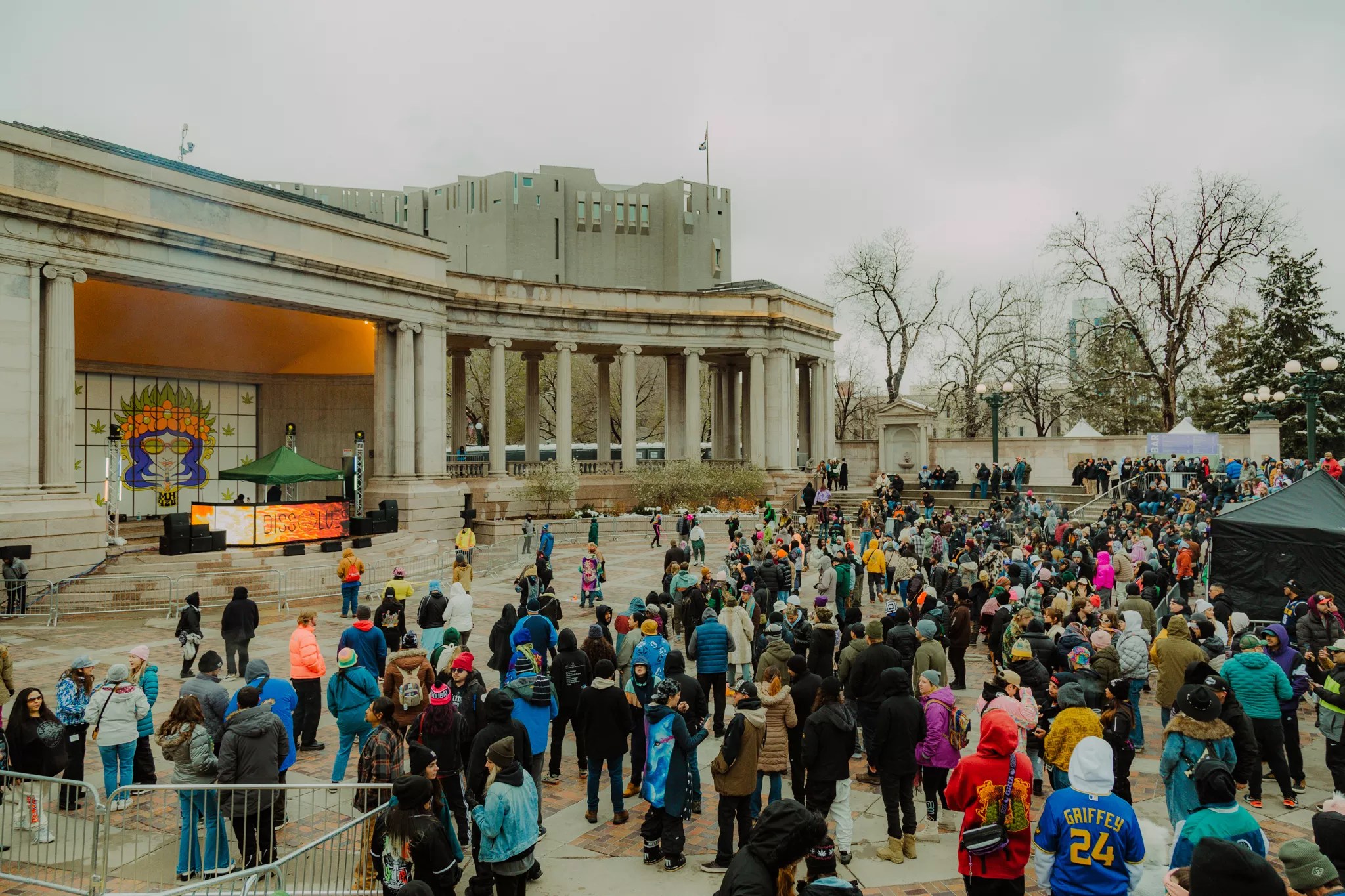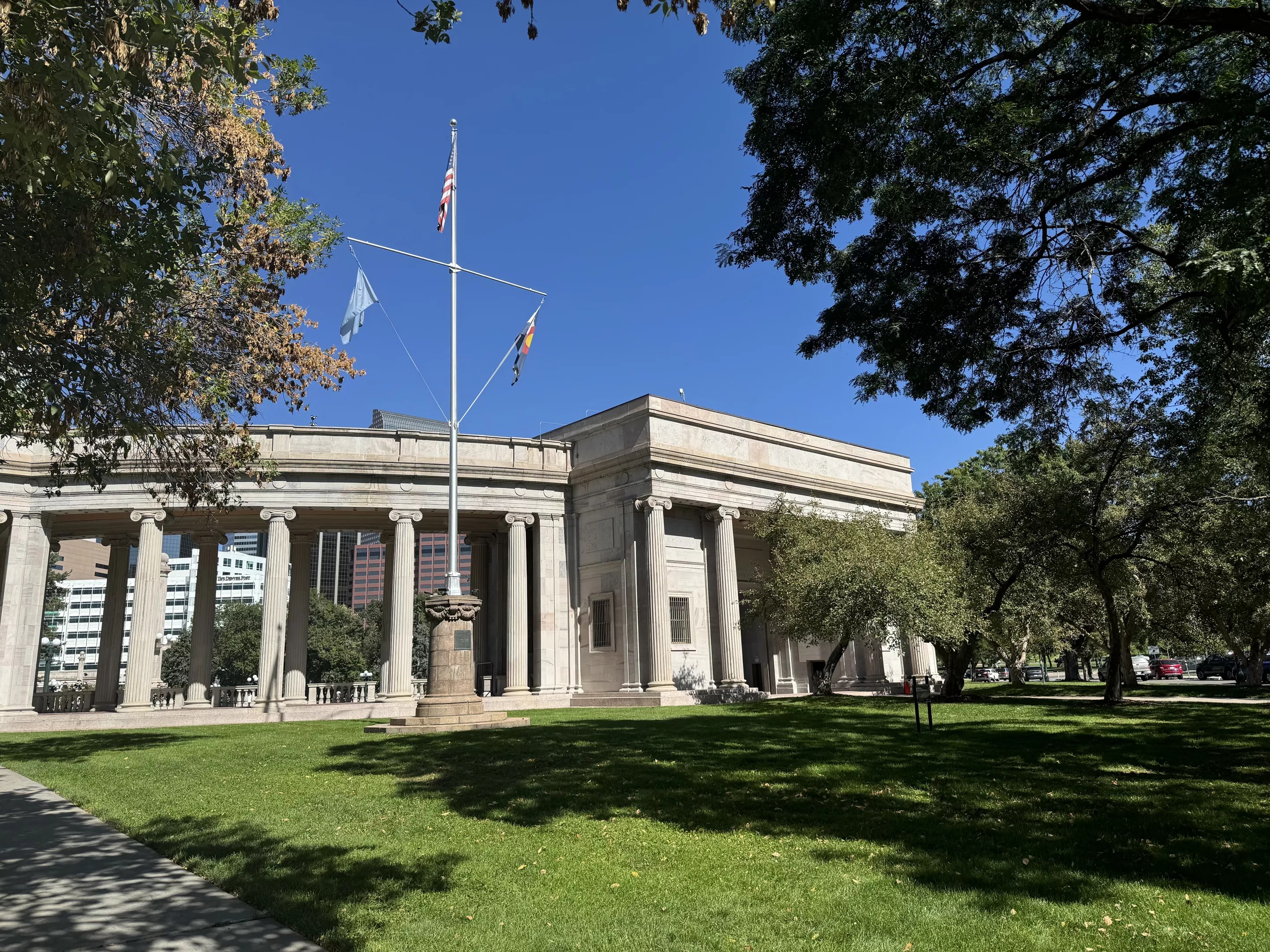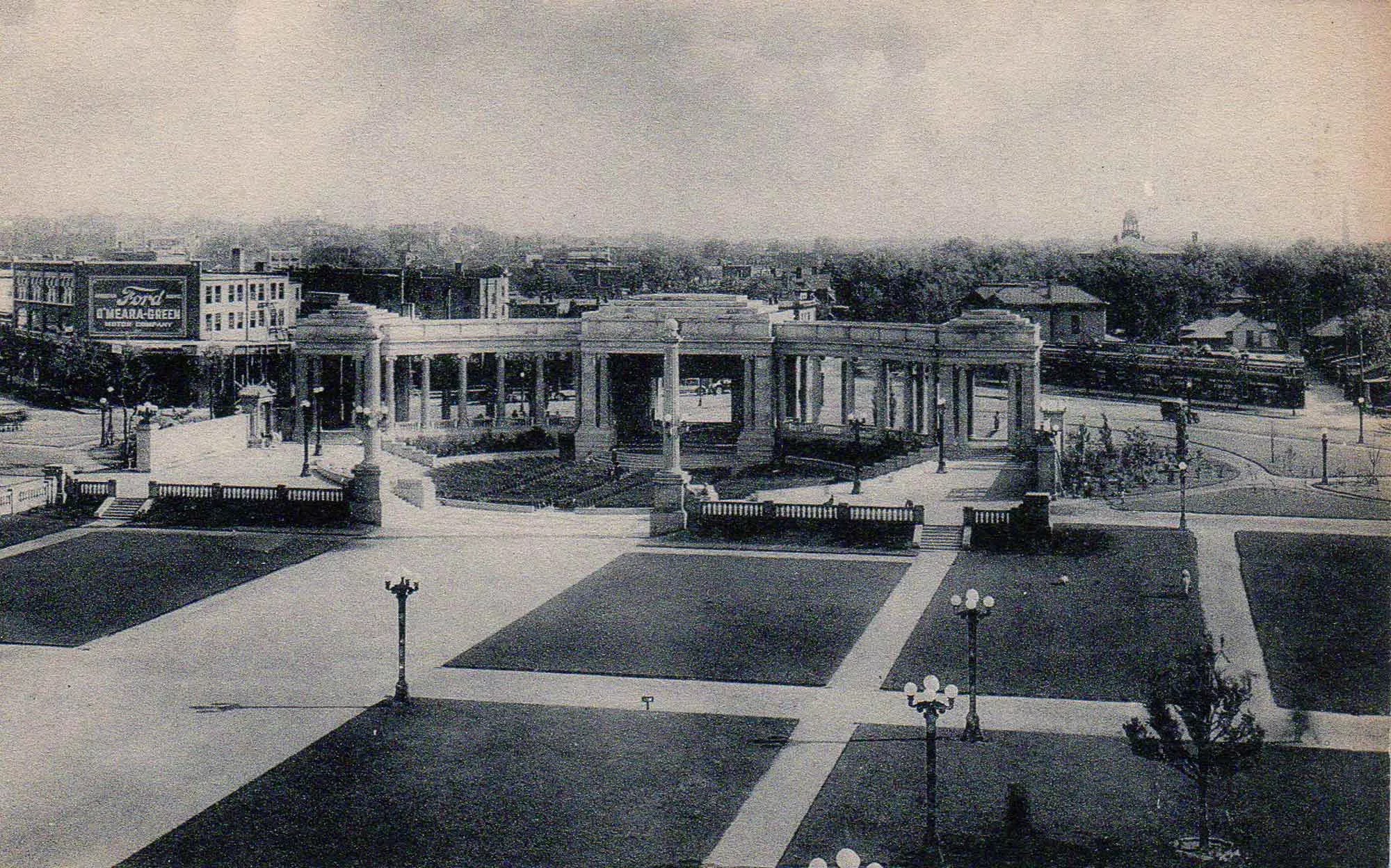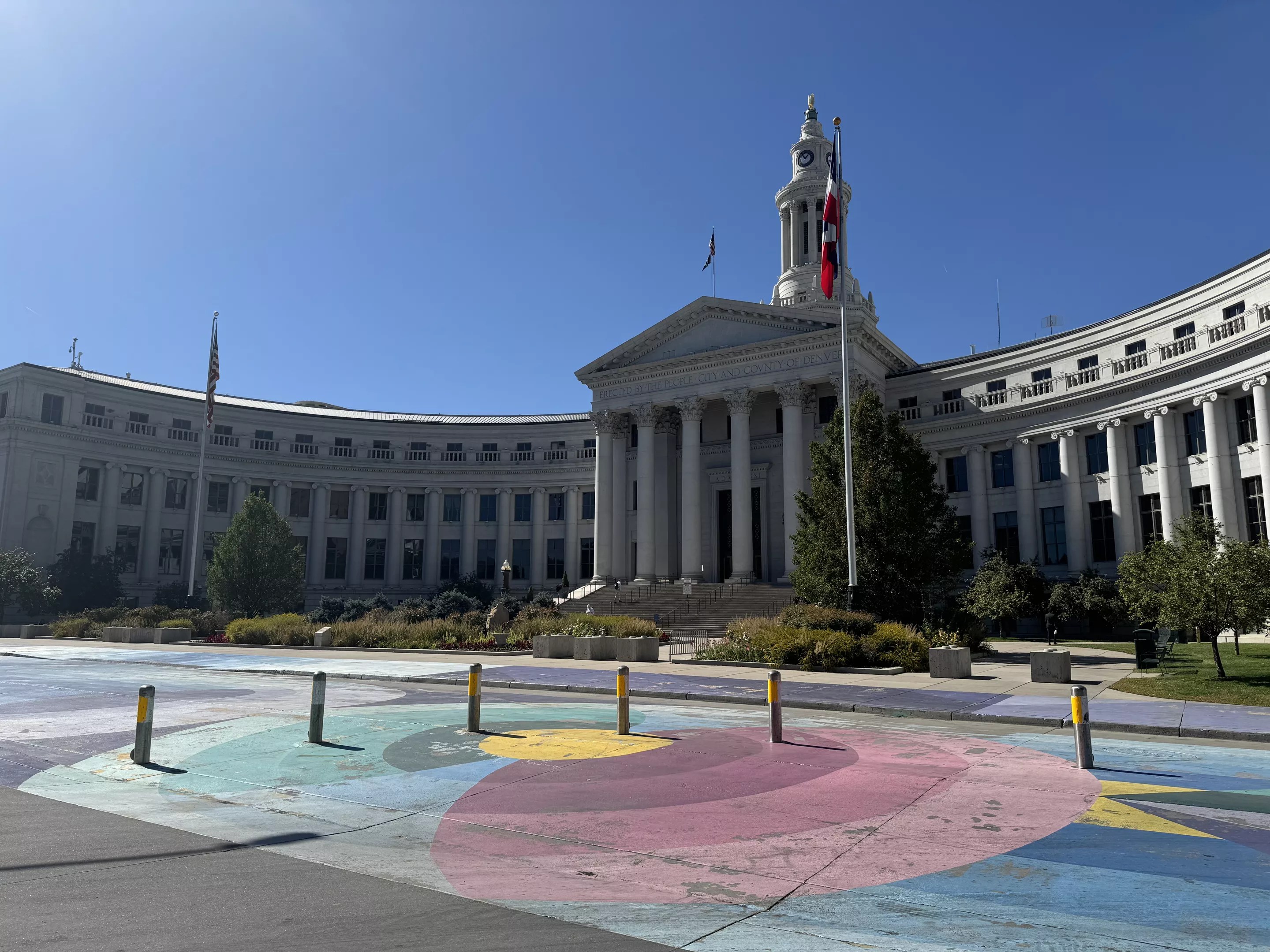
Brandon Johnson

Audio By Carbonatix
Civic Center Park will be transformed over the next few years, starting with a complete shift of the park’s famous Greek Amphitheater and changes to the promenade that connects the amphitheater on the park’s south side to the northern end bordering downtown.
The city, along with the Civic Center Conservancy – a nonprofit dedicated to programming activities in the park – has been developing the Civic Center Next 100 plan since 2021. Construction is scheduled to begin in 2025, and at the end of October, residents will get their first look at the designs for the park updates.
“We’re so excited about this project, and really believe that it’s going to be transformative for downtown Denver and have a very large economic impact on our city, bringing more residents to downtown, bringing more visitors to downtown and finding ways to keep people in downtown longer,” says Jenna Harris, downtown parks program manager for Denver Parks & Recreation.
The Civic Center Next 100 plan, released in 2022, is based on community feedback solicited by the city and the conservancy in 2021. As the Golden Triangle neighborhood grows and the 16th Street Mall renovations are completed over the next year, Civic Center Park will connect the two and continue to serve as a central gathering place for major Denver events and festivals, according to Harris.
This year, make your gift count –
Invest in local news that matters.
Our work is funded by readers like you who make voluntary gifts because they value our work and want to see it continue. Make a contribution today to help us reach our $50,000 goal!
“We’ve all been at this for twenty-plus years,” says Eric Lazzari, executive director of the Civic Center Conservancy. “This is not what the city has wanted. This is not what the conservancy has wanted, but it’s what the community has continued to tell both the conservancy and the city that they want out of Civic Center.”
The public weighed in on four key areas of the park: Bannock Street, which is wedged between the park and the City and County Building; the Greek Amphitheater; the central promenade; and a feature intended for central gatherings in the park that is part of the master plan but has yet to be developed.
The city will first tackle the amphitheater – including the south plaza that connects the amphitheater to the Denver Art Museum and the Central Library – and the promenade.

Plans call for reorienting the historic Greek Ampitheater.
CU Denver College of Architecture and Planning
Construction Will Transform Historic Greek Amphitheater
Construction was originally slated to begin this year but was postponed until 2025 because design and construction details weren’t fully worked out. The city and the conservancy hired Studio Gang in October 2023 as the main design firm. Led by Jeanne Gang, the firm also worked on the Populus Hotel, which will open this month right next to the park.
Harris says 30 percent of the Greek Amphiteater’s designs are complete.
Studio Gang was awarded a $2.8 million design contract for the project. Several landscape architecture firms are also involved in the designs.
The circa 1917 Greek Amphitheater is one of the park’s most well-known structures. Voters approved $4 million to refurbish it in 2017 as part of the Elevate Denver bond package. Part of the promise was to make the amphitheater a premier event venue for the city.
The city and conservancy are not ready to discuss the details, but multiple sources tell Westword that the orientation of the amphitheater will ultimately be switched. Instead of the main event space facing north, as it does now, it will face south, toward the art museum and library, offering a more intimate setting for performances. To maintain the historic nature of the amphitheater, nothing will be destroyed, but elements will be added around the structure to flip the direction of things.
“When we were looking at changes to the park, we recognized how underutilized the Greek Amphitheater is today,” Harris says. “It’s this amazing, iconic structure but has a lot of challenges for contemporary use, so it was a huge opportunity to kind of rethink how we could bring back the historic intent to use the Greek theater as both a civic and cultural centerpiece for our city with more contemporary infrastructure.”
Harris says community feedback indicated that the space’s outdated infrastructure is cost-prohibitive for events. For example, the stage itself has varying levels, which limits the amount of flat space for performers and bands. Additionally, there are no easy audiovisual hookups or lighting (adding both is included in the Next 100), and the stairs surrounding the theater make the space inaccessible for any visitors who are unable to navigate them.

This side of the Greek Amphitheater will be activated under the new plans, sources say.
Catie Cheshire
“It’s not accessible for audiences or for performers, and there’s no accessible connection from the public library and art museum through the park through the Greek theater,” Harris adds. “That’s one of the main challenges that we’re addressing, both for it to meet ADA and accessibility requirements [and] to better support performances.”
Another challenge for the theater: the sun. Harris notes that the brick theater bowl gets very hot in the afternoons as the sun arcs over the park. Plans in the Next 100 contemplate adding a shade structure atop the amphitheater.
The theater is also too large in scale, according to Harris.
“The Greek theater is actually the size of the [4,000-seat] Mission Ballroom,” she points out. “Many of the seats are on the outside. They’re very far from the performances, so it’s very over-scaled for the kinds of performances that we want to see take place there.”
The central promenade connecting the amphitheater to the Voorhies Memorial on the park’s north side will also be refurbished next year.
The promenade currently is a long, hot walkway that bakes in the sun and doesn’t offer much in the way of amenities. The Next 100 plan considers adding lighting, shade and infrastructure for use by event organizers, such as hidden power sheathing and places to hang temporary banners.
“What we’re hoping to do is improve the longevity of the central promenade, make it a more hospitable place,” Harris elaborates. “The other piece that we’re really looking to improve is event infrastructure, by improving utility connections so food trucks will be able to plug into electric infrastructure and we don’t have to run as many loud and environmentally-not-sustainable generators on the promenade.”
Those redesigns are the only currently funded phases of the Civic Center construction. Aside from the Elevate Denver money, partial funding came from the Parks & Recreation budget. Additionally, the Andrew W. Mellon Foundation gave Denver Parks & Rec a $2.3 million grant to support the project, and the National Park Service gave the department $750,000 toward the central promenade; donations from the Civic Center Conservancy have contributed to funding, too.
How Civic Center Became a Government and Cultural Hub
This isn’t the first time Denver has pulled together significant resources to improve Civic Center. In fact, the park was initially conceived in the early 1900s as a project to beautify Denver and make it measure up to other big cities around the world. But it was particularly inspired by the 1893 Columbian Exposition in Chicago attended by Robert Speer, who would later become Denver’s mayor.
Speer was inspired by the City Beautiful movement, which pushed for beautifying public spaces to create moral and civic virtue in cities. He brought those ideas to Denver as mayor in 1904, deciding that the government buildings should all be in a central plaza – but the two blocks southwest of Broadway and Colfax where Speer wanted to put the plaza at the time were occupied by shops, hotels and businesses.
Speer hired architect Charles Mulford Robinson to figure out a way to make that vision happen, but when Speer lost his reelection bid in 1912, the plans were put on hold. Speer was back in power by 1916, though, and he hired Chicago architect Edward H. Bennett to finalize plans and get construction going.
Bennett is the man who proposed the Greek Amphitheater, the column-heavy Colonnade and the seal pond that sits in the park today. He was also behind the way that Colfax Avenue and 14th Avenue curve around the park.
In 1916, the whole area that Civic Center now sits on was razed so that construction could begin, with the park officially opening in 1919. The Denver City and County Building, at the park’s west end, was not completed until 1932, however. The McNichols Building, an original Carnegie Library at the northwest corner of the park, is the only structure that predates Speer’s Civic Center plan.
The park is listed on the National Register of Historic Places. In 2012, the park, structures in the park, the State Capitol Building, Lincoln Park, the City and County Building and several other nearby buildings were designated as a National Historic Landmark.
But even landmarks need to change with the times, which city officials recognized in 2005 when they created a master plan for the park. That document paved the way for the current project and was the first official city document outlining the role the Civic Center Conservancy would play as an independent, nonprofit helper for the historic park.

The Greek Amphitheater was part of the new Civic Center Park, completed in 1919.
Western History Library
How Else Could the Park Change in the Next Decade?
Although the first phases of Civic Center construction are close to breaking ground, there are still two main aspects of the Next 100 vision left unfunded. One proposed project would integrate Bannock Street more fully into the park. Although the street has been closed to cars for several years, Next 100 intends to make the area into a plaza with a water feature, more greenery and spots for stages and pop-up markets.
“It will feel more like park space and not a road that’s adjacent to the park,” Harris explains.
Denver traditionally celebrates professional sports championships at Civic Center, near the City and County Building and on Bannock Street. Celebrations will still be possible, but they may have a different configuration. However, Harris notes that such updates are currently only in the planning phase. The department hopes to see them within the next five years but is still looking for funding.
The central gathering feature is also not funded and could be closer to a decade out, she adds.
“The central gathering feature is really intended to be a gathering place in the center of the park,” Harris says. “In the original plan, it was thought to be some kind of art element, potentially mixed with some kind of water-feature-type element, but it was not really fully realized.”
Additionally, the city has issued a request for proposals to place a museum in the McNichols Building, with potential plans for a restaurant that would spill out of McNichols and into the park.
Civic Center planners are still being inspired by Chicago, as well. Harris cites the Bean in Chicago’s Millennium Park as an example of the goal for the central gathering feature: something specific to Denver that becomes a destination.
Lazzari says the Civic Center Conservancy is ready to conduct more fundraising campaigns to help the final pieces of the vision fall into place; the parks department will also explore ways to fund future projects, including grants. In the meantime, the parks department hopes the first phase of construction will begin in the third quarter of 2025.

Bannock Street will eventually be integrated into Civic Center Park.
Catie Cheshire
Will Civic Center Park Be Closed During Construction?
The plans for Civic Center will go before the Landmark Preservation Commission this fall. Because the entire park is listed as a landmark, the commission could require alterations or disallow certain aspects of the project, but Harris believes the department’s plans are well within landmark guidelines. Once construction begins, people will still be able to use the park. Harris confirms that Parks & Rec does not plan to close the whole park, but rather just the promenade and Greek Amphitheater areas.
Those closures could impact events like Denver Pride, the Mile High 420 Fest, Denver’s Cinco de Mayo Festival and Civic Center EATS. Events that take place in other parts of the park will likely be able to go on as usual, though.
“We are working with our contractor to really think about the construction sequencing in a logical way that allows for as much of the park to be open as possible,” Harris says.
The construction contract includes stipulations that require the contractor to work around events when possible. Harris adds that the city is working with its permitting team to identify events that will need to relocate and to help them do so.
Lazzari says the conservancy also plans to continue to host programming in the park going forward.
“The park doesn’t have to go completely dark,” he says. “The conservancy is committed to both the community and the city to do our best to keep it active during construction with whatever land is available.”
Still, the timing of another construction project isn’t ideal for commuters around the city center and downtown, especially with the 16th Street Mall still a year from completion and the Colfax Bus Rapid Transit project just started, impacting the Colfax and Broadway intersection at the northeast end of Civic Center Park.
It could be a few years before the park is in full swing again, but the results should please people, Lazzari predicts.
“We’re really excited that the community is getting what it has continued to ask for,” he says. “They’ve wanted a Civic Center that is active, that is thriving, that is iconic, that is a true representation of what Denver is, where Denver can put its best foot forward. I really think in what we are going to start to share more publicly at the end of October, the public is going to see that.”
The city will hold a public update and conversation to share more details of the Civic Center Next 100 plan from 5:30 to 7 p.m. on Tuesday, October 29, at the former Denver Post building, 101 West Colfax Avenue.